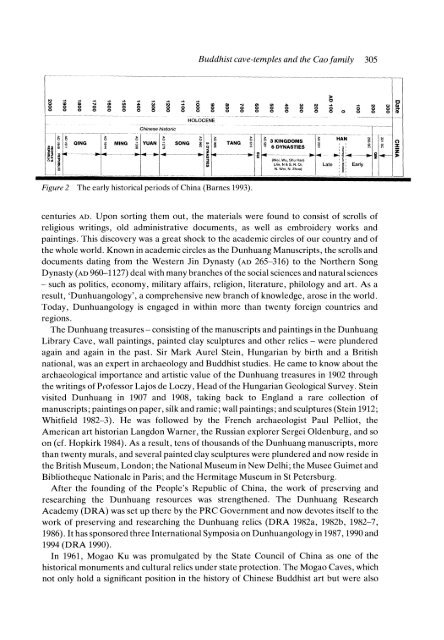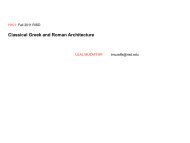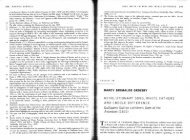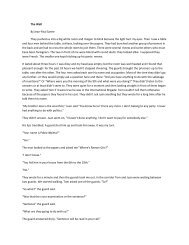Buddhist Cave-Temples and the Cao Family at Mogao Ku ...
Buddhist Cave-Temples and the Cao Family at Mogao Ku ...
Buddhist Cave-Temples and the Cao Family at Mogao Ku ...
You also want an ePaper? Increase the reach of your titles
YUMPU automatically turns print PDFs into web optimized ePapers that Google loves.
<strong>Buddhist</strong> cave-temples <strong>and</strong> <strong>the</strong> <strong>Cao</strong> family 305<br />
o <strong>at</strong> co -4 0 W (A 4- 0 0 01 -o 01 cm 4 ( 1 ' (A CD<br />
0 0 0 0 0 0 0 0 0 0 0 0 0 0 0 0 0 0 0 0 0 0<br />
0 0 0 0 0 0 0 0<br />
0<br />
0 0 0 0 0 0 0 0 0 0 0 0 0 0 0 0<br />
Chinese historic<br />
HOLOCENE<br />
>o<br />
-<br />
0 a 0 0 0 , 3 KINGDOMS HAN<br />
G QING MING YUAN SONG TANG 6DYNASTIES<br />
gjfjl^ ~ ?<br />
S 3 ?? 6 DYNASTIES<br />
'<br />
?---*~4<br />
-r ~<br />
--- --- -C1 --~4--~- 4-------) ~4--- ~- g 4--------- c 4<br />
;r5 3 (0 d--(Wei, Wu, Shu Han)<br />
gm (Jin, N, Qi, L<strong>at</strong>e Early<br />
N. Wei, N. Zhou)<br />
Figure 2 The early historical periods of China (Barnes 1993).<br />
centuries AD. Upon sorting <strong>the</strong>m out, <strong>the</strong> m<strong>at</strong>erials were found to consist of scrolls of<br />
religious writings, old administr<strong>at</strong>ive documents, as well as embroidery works <strong>and</strong><br />
paintings. This discovery was a gre<strong>at</strong> shock to <strong>the</strong> academic circles of our country <strong>and</strong> of<br />
<strong>the</strong> whole world. Known in academic circles as <strong>the</strong> Dunhuang Manuscripts, <strong>the</strong> scrolls <strong>and</strong><br />
documents d<strong>at</strong>ing from <strong>the</strong> Western Jin Dynasty (AD 265-316) to <strong>the</strong> Nor<strong>the</strong>rn Song<br />
Dynasty (AD 960-1127) deal with many branches of <strong>the</strong> social sciences <strong>and</strong> n<strong>at</strong>ural sciences<br />
- such as politics, economy, military affairs, religion, liter<strong>at</strong>ure, philology <strong>and</strong> art. As a<br />
result, 'Dunhuangology', a comprehensive new branch of knowledge, arose in <strong>the</strong> world.<br />
Today, Dunhuangology is engaged in within more than twenty foreign countries <strong>and</strong><br />
regions.<br />
The Dunhuang treasures - consisting of <strong>the</strong> manuscripts <strong>and</strong> paintings in <strong>the</strong> Dunhuang<br />
Library <strong>Cave</strong>, wall paintings, painted clay sculptures <strong>and</strong> o<strong>the</strong>r relics - were plundered<br />
again <strong>and</strong> again in <strong>the</strong> past. Sir Mark Aurel Stein, Hungarian by birth <strong>and</strong> a British<br />
n<strong>at</strong>ional, was an expert in archaeology <strong>and</strong> <strong>Buddhist</strong> studies. He came to know about <strong>the</strong><br />
archaeological importance <strong>and</strong> artistic value of <strong>the</strong> Dunhuang treasures in 1902 through<br />
<strong>the</strong> writings of Professor Lajos de Loczy, Head of <strong>the</strong> Hungarian Geological Survey. Stein<br />
visited Dunhuang in 1907 <strong>and</strong> 1908, taking back to Engl<strong>and</strong> a rare collection of<br />
manuscripts; paintings on paper, silk <strong>and</strong> ramie; wall paintings; <strong>and</strong> sculptures (Stein 1912;<br />
Whitfield 1982-3). He was followed by <strong>the</strong> French archaeologist Paul Pelliot, <strong>the</strong><br />
American art historian Langdon Warner, <strong>the</strong> Russian explorer Sergei Oldenburg, <strong>and</strong> so<br />
on (cf. Hopkirk 1984). As a result, tens of thous<strong>and</strong>s of <strong>the</strong> Dunhuang manuscripts, more<br />
than twenty murals, <strong>and</strong> several painted clay sculptures were plundered <strong>and</strong> now reside in<br />
<strong>the</strong> British Museum, London; <strong>the</strong> N<strong>at</strong>ional Museum in New Delhi; <strong>the</strong> Musee Guimet <strong>and</strong><br />
Biblio<strong>the</strong>que N<strong>at</strong>ionale in Paris; <strong>and</strong> <strong>the</strong> Hermitage Museum in St Petersburg.<br />
After <strong>the</strong> founding of <strong>the</strong> People's Republic of China, <strong>the</strong> work of preserving <strong>and</strong><br />
researching <strong>the</strong> Dunhuang resources was streng<strong>the</strong>ned. The Dunhuang Research<br />
Academy (DRA) was set up <strong>the</strong>re by <strong>the</strong> PRC Government <strong>and</strong> now devotes itself to <strong>the</strong><br />
work of preserving <strong>and</strong> researching <strong>the</strong> Dunhuang relics (DRA 1982a, 1982b, 1982-7,<br />
1986). It has sponsored three Intern<strong>at</strong>ional Symposia on Dunhuangology in 1987, 1990 <strong>and</strong><br />
1994 (DRA 1990).<br />
In 1961, <strong>Mogao</strong> <strong>Ku</strong> was promulg<strong>at</strong>ed by <strong>the</strong> St<strong>at</strong>e Council of China as one of <strong>the</strong><br />
historical monuments <strong>and</strong> cultural relics under st<strong>at</strong>e protection. The <strong>Mogao</strong> <strong>Cave</strong>s, which<br />
not only hold a significant position in <strong>the</strong> history of Chinese <strong>Buddhist</strong> art but were also





